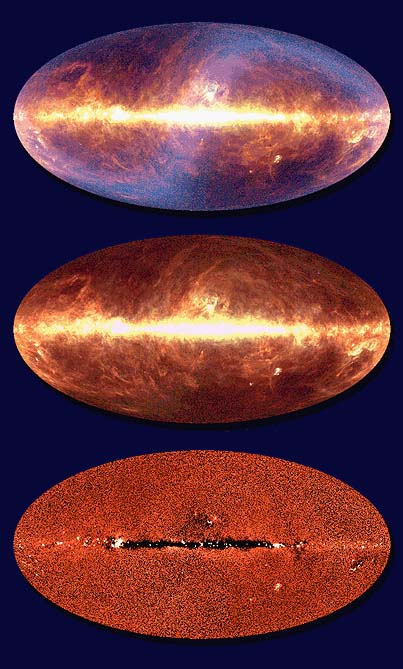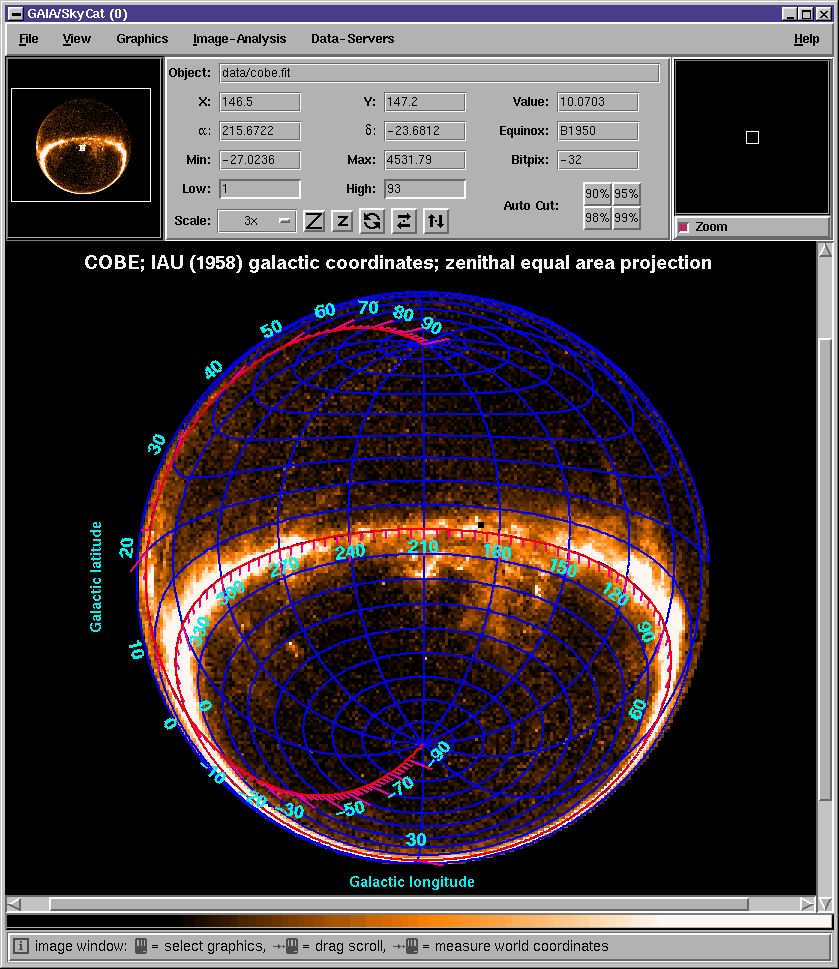The New York Pravda makes the effort to explain what the latest Nobel Prize in Physics is all about for the mercantile classes:

FOURTEEN years ago, when a Berkeley astronomer named George F. Smoot declared that he and his satellite, the Cosmic Background Explorer, or COBE, had detected the astrophysical equivalent of the fingerprints of God, his euphoria was easy to understand. For a few happy years, one of the last big pieces of the cosmological puzzle seemed to be in place — an explanation why the universe has blossomed into such an interesting place to live.

Had it not been for the whorls and dimples Dr. Smoot and his NASA collaborator, John C. Mather, found in the background radiation — the afterimage of the Big Bang — there would be no cosmic scenery. No galaxies or other vast conglomerations of matter, just a smooth expanse of visual nothing. Kansas instead of Colorado...
It's easier to visualize what this means if you use a simple light/ dark projection of the data instead of being so mystically psychedelic in your data depiction:

[An aside: The purpose of the Cosmic Background Explorer (COBE) mission was to take precise measurements of the diffuse radiation between 1 micrometer and 1 cm over the whole celestial sphere. The following quantities were measured: (1) the spectrum of the 3 K radiation over the range 100 micrometers to 1 cm; (2) the anisotropy of this radiation from 3 to 10 mm; and, (3) the spectrum and angular distribution of diffuse infrared background radiation at wavelengths from 1 to 300 micrometers.
The experiment module contained the instruments and a dewar filled with 650 liters of 1.6 K liquid helium, with a conical sun shade. The base module contained the attitude control, communications and power systems. The satellite rotated at 1 rpm about the axis of symmetry to control systematic errors in the anisotropy measurements and to allow observations of the zodiacal light at various solar elongation angles. The orientation of the spin axis was maintained anti-earth and at 94 degrees to the sun-earth line. The operational orbit was dawn-dusk sun-synchronous so that the sun was always to the side and thus was shielded from the instruments. With this orbit and spin-axis orientation, the instruments performed a complete scan of the celestial sphere every six months.
Instrument operations were terminated 1993-12-23. As of January 1994, engineering operations were to conclude that month, after which operation of the spacecraft would be transferred to Wallops for use as a test satellite.
Another projection of the image:
 ]
]Back to Pravda for the masses:
...Subsequent discoveries have muddled the picture, so much so that last week’s announcement that the two men will share a Nobel Prize in physics was almost bittersweet — an occasion to celebrate a pivotal moment in science but also to look back with nostalgia on more innocent times.
The creation story supported by the data from the COBE satellite had seemed almost tantalizingly complete. Dr. Smoot’s smudges themselves weren’t sticky enough to gather particles into globs the size of the Milky Way or the Virgo supercluster. But if you spiked the Big Bang with an invisible additive called dark matter — a clumping factor — and hot-rodded the theory with a brief, early burst of rapid expansion called cosmological inflation, you could get the tiny irregularities in the background radiation to sprawl into something like today’s sky.
If only it had been that simple. Six years after COBE, another Berkeley scientist, Saul Perlmutter, found something that almost no one had expected. By now, it was assumed, the universe should have settled down, expanding at a steady pace or even slowing, braked by its own gravity. Instead it appeared to be in overdrive, not ballooning as violently as it had in the inflationary era but expanding at a faster and faster rate. Something seemed to be pushing on the accelerator — what has come to be called dark energy, a mysterious kind of anti-gravity.
Shoehorning the new ingredient into the prevailing framework has created new Nobel-sized problems. Basic physics predicts that if it exists at all, this repulsive force should be extremely large. Instead, the dark energy is infinitesimal and no one has been able to say why.
Except, that is, for followers of a controversial doctrine called the anthropic principle. There is no fundamental reason, they say, why the dark energy is so weak. It is just that if it were much stronger, space would have expanded too rapidly to harbor stars and, ultimately, life. The implication is that there is a multitude of possible universes, each with its own physics. Naturally, we are in one where it is possible for us to exist.
Depending on their temperament, physicists find the idea of a spectrum of universes each ruled by different laws either liberating or a source of despair. Since the days of the Greek philosophers, the reigning assumption, more mystical than scientific, has been that things are necessarily the way they are. There is one universe and lurking somewhere within is a deep principle that explains why the strength of gravity, the speed of light, the heft of matter — all the constants of nature — have taken certain values.
With Smoot and Mather, science seemed closer to finding the key — a hope that now sometimes seems as egotistical as the pre-Copernican belief that we live at the center of creation instead of on a hospitable rock orbiting an obscure star in an obscure galaxy in a universe that may be obscurer still.
More recently this faith in our own uniqueness has been tested again by a related finding in superstring theory, which began some 30 years ago as an attempt to pull all the numbers of the cosmos from a few basic calculations. Just as x + y + z = 42 has many solutions (infinitely many if you allow fractions or negative numbers), so do the equations of superstring theory. By one reckoning, the number of conceivable universes, each with a different dose of dark energy, is so vast that it is “measured not in the millions or billions but in googols or googolplexes.” (Before it was retooled into the name of a search engine, a googol was defined as 10 to the power of 100 and a googolplex as 10 to the power of googol.) Why we find ourselves in, say, universe number 110,310,077,252 would again be a tautology: if we weren’t we wouldn’t be here to ask. There may yet be a way out of the muddle with some insight that focuses superstrings into a beam illuminating the one true theory.

But new ideas, some physicists complain, are a dime a dozen. What they crave is new data, perhaps from the Large Hadron Collider scheduled to go online near Geneva next year. What is discovered there might do for physics what the COBE measurements did for cosmology in 1992: provide some long-needed reality testing.
If not there is always Plan B.
 Maybe physicists in another universe are coming closer to an answer.
Maybe physicists in another universe are coming closer to an answer.Doubtless an infinite number already have.
Me, I'm hitchhiking a ride the next time John Titor passes through.
I'm willing to pay for gas, too. In the multiverse, it's always better to pay as you go. Infinite interest is teh beotch to pay.
Doubtless there is a grand unifying theory of everything. The facts, if not the Truths, are out there
 . Most of us, I've been told
. Most of us, I've been told  , just aren't ready for it yet.
, just aren't ready for it yet.

3 comments:
The fact that after that facinating post you make a comment about John Titor makes me wonder if you are me in an alternative universe. Only the me that is you me is MUCH smarter and lives in another part of the country.
John Titor! That just cracked me up! I read so many time travel science fiction my friends joke about it. The funny thing, if I had a chance to travel to the past? I'd pass. The real past is a NASTY place to be. I like hot water and penicillin thank you very much!
BTW, since we seem to share views on lots of stuff, check out BSG this season. I downloaded it (Itunes has it) I Netflixed the first two seasons. Science wise I'm sure we can pit nits (a bit of sound in space? artisitic licenese I say.) but the stories are real and deals with lots of real human struggles. Spocko says check it out.
I believe somewhere in the Titor mythos is the observation that it is impossible to travel in time precisely in the same world line.
You can (hypothetically) end up somewhere close to your universe. Like "Earth without the letter 'j' " for instance. Thus all the paradoxes with time travel are removed- you iust enter at a different place along the world line vector of a very similar universe. Iust don't make a hobbit of it.
This assumes, of course, conservation of matter and energy works across different worldlines. For example, it would be a very short visit if you stepped into an antimatter universe.
And BSG rocks, of course.
Oh I had forgotten that about Titor. I remember that always made some kind of sense. In one of his books, HOMINIDS I believe Robert Sawyer did a bit about Quantum computers and parallel world lines. It's always amusing to me when SF authors all latch onto the latest fad. I remember multiple books about Superstring theory and quantum foam coming out. Now, it's parallel universes.
Why can't they get back to good ol'
"Nuclear weapon makes giant ants" stories? I'm hoping that with today's test that will restart that genre.
Post a Comment